Routes ofadministration by injection only CAS Number 145-63-1 Molar mass 1,297.29 g/mol | Legal status US: Not FDA approved PubChem CID 5361 Classification Sulfonic acid | |
 | ||
Trade names Antrypol, 309 F, 309 Fourneau, Bayer 205, Moranyl, Naganin, Naganine Trade name Antrypol, 309 F, 309 Fourneau, Bayer 205, Moranyl, Naganin, Naganine | ||
Suramin is a medication used to treat African sleeping sickness and river blindness. It is the treatment of choice for sleeping sickness without central nervous system involvement. It is given by injection into a vein.
Contents
- Medical uses
- Pregnancy and breastfeeding
- Adverse reactions
- Pharmacokinetics
- Chemistry
- Mechanism of action
- History
- Research
- References
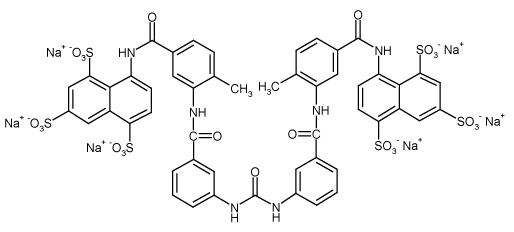
Suramin causes a fair number of side effects. Common side effects include nausea, vomiting, diarrhea, headache, skin tingling, and weakness. Sore palms of the hands and soles of the feet, trouble seeing, fever, and abdominal pain may also occur. Severe side effects may include low blood pressure, decreased level of consciousness, kidney problems, and low blood cell levels. It is unclear if it is safe when breastfeeding.
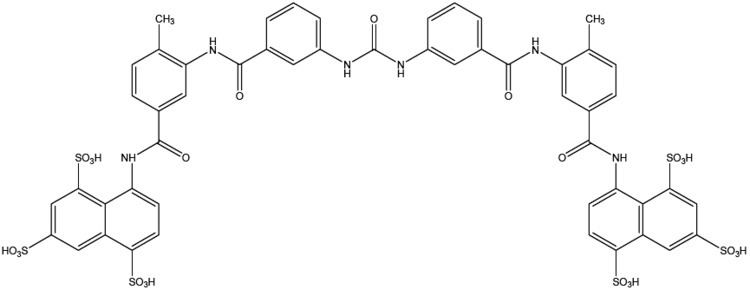
Suramin was made at least as early as 1916. It is on the World Health Organization's List of Essential Medicines, the most effective and safe medicines needed in a health system. In the United States it can be acquired from the Center for Disease Control (CDC). The cost of the medication for a course of treatment is about 27 USD. In regions of the world where the disease is common suramin is provided for free by the World Health Organization.
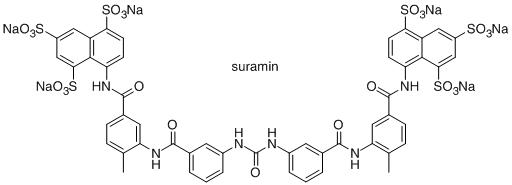
Medical uses
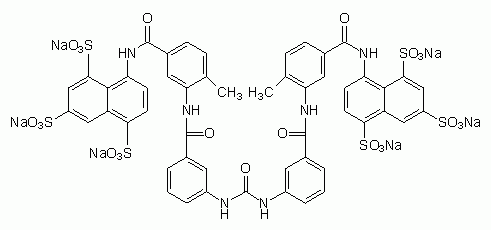
Suramin is used for treatment of human sleeping sickness caused by trypanosomes. Specifically, it is used for treatment of first-stage African trypanosomiasis caused by Trypanosoma brusei rhodesiense without involvement of central nervous system. It is considered second-line treatment for early-stage disease due to its side effects.
It has been used in the treatment of river blindness (onchocerciasis).
Pregnancy and breastfeeding
It is unknown whether it is safe for the baby when a women takes it while breastfeeding.
Adverse reactions
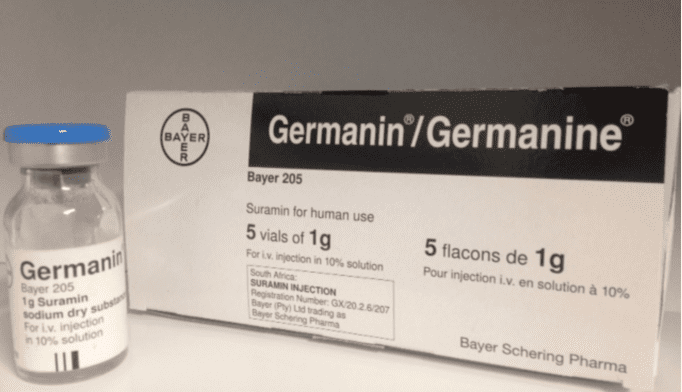
The most frequent adverse reactions are nausea, vomiting, diarrhea, abdominal pain, general feeling discomfort. It is also common to experience various sensations in the skin, from crawling or tingling sensations, tenderness of palms and the soles, and numbness of hands, arm, legs or feet. Other skin reactions include skin rash, swelling and stinging sensation. Suramin can also cause loss of appetite and irritability. Suramin causes non-harmful changes in urine during use, specifically making the urine cloudy.

Less common side effects include extreme fatigue, ulcers in the mouth, and painful tender glands in the neck, armpits and groin. Suramin uncommonly affects the eyes causing watery eyes, swelling around the eyes, photophobia, and changes or loss of vision.
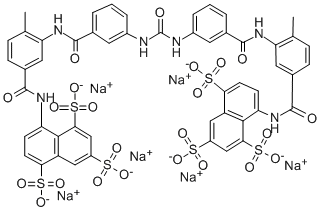
Rare side effects include hypersensitivity reactions causing difficulty breathing. Other rare systemic effects include decreased blood pressure, fever, rapid heart rate, and convulsions. Other rare side effects include symptoms of liver dysfunction such as tenderness in upper abdomen, jaundice in eyes and skin, unusual bleeding or bruising.
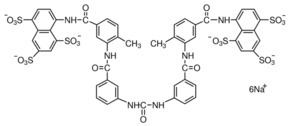
Suramin has been applied clinically to HIV/AIDS patients resulting in a significant number of fatal occurrences and as a result the application of this molecule was abandoned for this condition.
Pharmacokinetics
Suramin is not orally bioavailable and is given intravenously. Intramuscular and subcutaneous administration could result in local tissue inflammation or necrosis. Suramin is approximately 99-98% protein bound in the serum and has a half-life of 41–78 days; however, the pharmacokinetics of suramin can vary substantially between individual patients. Suramin does not distribute well into cerebral spinal fluid and its concentration in the tissues is equivalently lower than its concentration in the plasma. Suramin is not extensively metabolized and about 80% is eliminated via the kidneys.
Chemistry
The molecular formula of suramin is C51H40N6O23S6. It is a symmetric molecule in the center of which lies a urea (NH–CO–NH) functional group. Suramin contains eight benzene rings, four of which are fused in pairs (naphthalene), four amide groups (in addition to the urea) and six sulfonic acid groups. When given as drug, it is usually as the sodium sulfonate, with six sodium ions on the sulfonate groups rather than hydrogens. This formulation is soluble in water, but deteriorates rapidly in air.
Mechanism of action
The mechanism of action for suramin is unclear, however, it is thought that parasites are able to selectively uptake suramin via receptor-mediated endocytosis of drug that is bound to low-density lipoproteins and to a lesser extent, other serum proteins. Once inside parasites, suramin combines with proteins, especially trypanosomal glycolytic enzymes to inhibit energy metabolism.
History
It was developed by Oskar Dressel and Richard Kothe of Bayer, Germany in 1916, and is still sold by Bayer under the brand name Germanin. The formula of suramin was kept secret by Bayer for commercial reasons, however, it was elucidated and published in 1924 by Ernest Fourneau and his team of the Pasteur Institute.
Research
It is also used as a research reagent to inhibit the activation of heterotrimeric G proteins in a variety of GPCRs with varying potency. It prevents the association of heteromeric G proteins and therefore the receptors guanine exchange functionality (GEF). With this blockade the GDP will not release from the Gα subunit so it can not be replaced by a GTP and become activated. This has the effect of blocking downstream G protein mediated signaling of various GPCR proteins including rhodopsin, the A1 adenosine receptor, the D2 receptor, the P2 receptor, and ryanodine receptors.
Suramin was studied as a possible treatment for prostate cancer in a clinical trial.
It has been studied in a mouse model of autism
Its effect on telomerase has been investigated.
Its activity against RNA viruses has been studied.
Suramin has also been studied as an inhibitor of the brown spider venom phospholipase-D.
